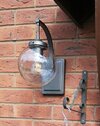Looking for a recommendation on a sealant please.
I've just replaced an old outside light. The new one didn't come with any gasket! What's the best sealant for a metal outside light on brick. Can acetoxy cure be used or will it react with the brick or metal?
I've just replaced an old outside light. The new one didn't come with any gasket! What's the best sealant for a metal outside light on brick. Can acetoxy cure be used or will it react with the brick or metal?


